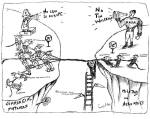|

Articles:
Technical Briefs Home
The President's Corner
Molding Compound Lawsuit Quietly
Settled
Lead-Free and the Military / Aerospace
Dilemma
GEIA Hot Solder Dip Specification
Ionic Contamination at the Component
Level
Column Grid Array: The Solution
to BGA Reliability Problems

|
Lead-Free and the Military / Aerospace Dilemma
Beginning in July 2006, the European Union Directive on the restriction of
the use of certain hazardous substances in electrical and electronic equipment
(commonly referred to as RoHS) will be enforced throughout Europe. RoHS
restricts the use of six substances, including lead, which is commonly used in
electronics. Manufacturers outside of Europe will have to abide by RoHS if they
intend to sell electrical and electronic equipment into Europe.
The RoHS directive has succeeded in driving semiconductor and electronics
companies to qualify and adopt lead-free solders.
This is a dilemma for military and
aerospace. They are being forced to use components and processes that are
unproven and, in certain situations, known to be less reliable. Even though
military and aerospace users are exempt from RoHS, the availability of tin-lead
finished components is quickly diminishing and is likely to vanish altogether.
In order to meet the RoHS mandate and minimize inventory costs, semiconductor
and component manufacturers are converting to lead-free solder alloys worldwide.
Almost all components, except Ball Grid Arrays (BGA), are moving to pure-tin
finishes. Ball grid arrays are moving to tin-silver-copper (SAC) alloys.
| Pure-tin finishes present a huge problem for the military
and aerospace community. These finishes are known to be prone to tin-whisker
growth. Tin whiskers have caused failures of several weapon and satellite
systems, as well as a nuclear reactor shutdown.
The simplest solution to this tin-whisker dilemma is Hot Solder Dip (HSD).
It can be used to convert pure-tin finishes to tin-lead or lead-free. Hot
solder dipping is a well-established process that has been used in the
semiconductor industry for decades. |

Figure 1: Tin Whiskers [1]
|
The military and aerospace industries face another issue as they try to
incorporate the lead-free BGAs into a tin-lead environment. Studies have shown
that lead-free BGA components are incompatible with tin-lead solders.
The simplest solution to this dilemma is BGA reballing. It can be used to
convert lead-free BGAs to tin-lead.
For more information:
Visit: www.sixsigmaservices.com
E-mail: sales@solderquik.com
Call: 408-956-0100
Six Sigma is actively involved in alloy conversions for military and
aerospace customers. Six Sigma, with its history of providing services for the
semiconductor industry for over 15 years, has proven to be the leader in the
field of hot solder dip,
BGA reballing and
column attach services. During this
time Six Sigma has processed over 20 million components for high-reliability
applications.
Reference:
[1] Galyon, G., J. Smetana and N. Vo (2004). Cause of Tin Whiskers
Remains Elusive [Online]. Available at
http://smt.pennnet.com/Articles/Article_Display.cfm?Section=Articles&Subsection=Display&ARTICLE_ID=216213
(accessed July 31, 2005).
Six Sigma: Subscribe
|